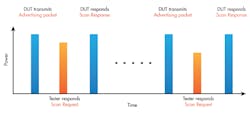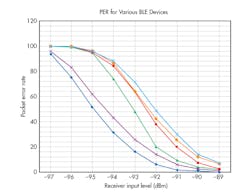Over-the-Air BLE Test Systems Pinpoint Wireless Quality Issues
Bluetooth Low Energy (BLE) is rapidly becoming one of the most widely deployed wireless technologies, finding use in a wide range of applications such as asset tracking, fitness monitoring, location services, and remote sensing. BLE devices are often small and ruggedized, and in many cases fully encapsulated in a protective housing to protect against environmental effects. This packaging adds a unique challenge for design and test engineers: How can the wireless performance be verified without any RF or digital connections?
One alternative is over-the-air (OTA) BLE testing, which provides rapid parametric verification of transmitter and receiver performance. Both transmitter and receiver are equally important, but validating OTA performance of the receiver in BLE is especially challenging and requires a new measurement methodology. This article examines new measurement techniques developed specifically to determine BLE OTA packet error rate (PER) and receiver sensitivity.
OTA Testing Solves Two Key Challenges
Challenge #1: In typical non-OTA testing, a digital communication method such as UART or USB connection is used to control the device under test (DUT). For receiver tests, the device will be set up to start receiving packets, a test system will then send a known number of packets, and the device will be queried to determine how many packets were successfully received. The information allows the test system to calculate PER, which is an industry standard method to quantify receiver performance. For OTA testing, there’s no direct wired communication and the challenge is to design a new method to determine if packets were properly received.
Solution #1: To determine PER without a wired connection, an OTA test solution must leverage standard BLE over-the-air protocol messages to determine if packets are received. BLE devices transmit on three specific advertising frequencies, which are spaced across the 2.4-GHz band.
1. The diagram illustrates power versus time for a BLE advertisement, Scan Request, and Scan Response event.
For devices with receivers, each time they transmit an advertising packet, they listen for a brief period for a specific BLE message called a Scan_Request. This message is normally used by nearby devices that may wish to communicate with the advertiser. If the advertising device receives this Scan_Request, it will respond with a Scan_Response message. This pattern is illustrated in the power versus time plot shown in Figure 1. The advertiser sends an advertisement packet, shown in blue, which is followed by a Scan_Request message from a nearby station, (shown in orange), and the advertiser follows up with a Scan_Response message, again shown in blue.
This exchange of messages is used in normal operation of BLE devices, and the OTA test system exploits this behavior to measure PER. During a receiver test, the DUT sends an advertisement, the test system sends a Scan_Request, and if the DUT received the packet, it acknowledges with the Scan_Response. The test system keeps track of the number of Scan_Request messages that are sent and the number of Scan_Responses received. This information is used to calculate receiver PER.
For sensitivity measurements, the test system adjusts the RF signal level to find the RF level that produces a specific PER. This RF level, known as receiver sensitivity, is a common method used to specify receiver quality. The method using the advertising packets, Scan_Request messages, and Scan_Response is implemented in the BLE OTA tester, and accurately determines receiver PER or sensitivity without any direct wired communications with the DUT.
Challenge #2: BLE technology has low data rates when compared to other common wireless technologies, such as Wi-Fi or cellular. For receiver tests, a large number of packets are required to perform measurements that are statistically significant and accurate.
With low data rates, BLE receiver tests in a production environment would take a long time, which adds significant cost. Long test times and higher costs of course aren’t acceptable, so the second challenge is to design a new measurement method to accurately determine PER using significantly less packets than existing, traditional PER test methods.
Solution #2: Receiver sensitivity is typically performed by measuring PER over a range of RF levels. Bluetooth SIG, the specification body for Bluetooth performance, has specified that 1,500 packets must be used to measure receiver sensitivity. Using the advertising method described previously, a typical BLE device would take several minutes at each level to receive this many packets. Furthermore, assuming it was measured over multiple RF levels, a complete receiver sensitivity test could take more than 10 minutes.
This is clearly unacceptable in many applications, and demands a new, faster method. To resolve the issue, an OTA test solution must use an algorithm to rapidly determine a PER distribution curve. This method, referred to as “fast PER,” is designed to quickly determine the receiver sensitivity point that produces 50% PER.
During a fast PER test, the tester begins by sending a single packet (Scan_Request) at an arbitrary RF level. If the packet is acknowledged, the RF level is lowered and the next packet is sent at this new lower level. If the packet wasn’t acknowledged, the RF level is increased, and the next packet will be sent at this higher level. By using an intelligent algorithm to adjust RF-level step sizes and keep record of which levels were acknowledged and those that were not, a “Packet Error distribution curve” can quickly and accurately be created with a minimal number of packets.
2. These packet-error-rate (PER) curves are typical for BLE DUTs.
Figure 2 shows a traditional PER curve for a BLE device. The PER curve is most sensitive to RF-level changes at the 50% point of the curve, and for this reason the fast PER algorithm searches for this 50% point. During the RF-level changes, most of the packets are sent at an RF level near the 50% point; the RF step sizes are adjusted to smaller steps as the algorithm converges on this 50% region. This produces a very repeatable and accurate measurement of the DUT receiver sensitivity and requires <5% of the number of packets that would be necessary with a traditional brute-force PER sweep using a large number of packets at a range of different RF levels.
Summary
RF designers need to validate customer-ready product performance with completed designs and not just rely on board-level measurements, where RF performance can be drastically different than the finished product. In manufacturing, test engineers often don’t have access to board-level RF and digital connections, so they need fast test methods that can be performed over-the-air to provide accurate and repeatable results.
OTA BLE test solutions solve these key measurement challenges. These systems enable engineers to build better designs, and allow manufacturers to use parametric data to validate manufacturing quality. In BLE, wireless performance is critical because if the wireless communications don’t work well, the device doesn’t work well. Designing a better product and ensuring it’s built properly is now much easier with these BLE OTA test solutions.
About the Author
Allen Henley
Senior Product Manager
Allen Henley is senior product manager at LitePoint, where he is responsible for cellular, Wi-Fi, Bluetooth, and IoT test solutions. Prior to LitePoint, Allen held product-management roles at Fluke, Agilent Technologies, and Hewlett-Packard. He earned a BS in electrical engineering from California Polytechnic State University-San Luis Obispo and an MSEE from Washington State University. Allen is actively involved with his local school district STEM education programs to encourage high-school students to pursue rewarding careers in engineering.



